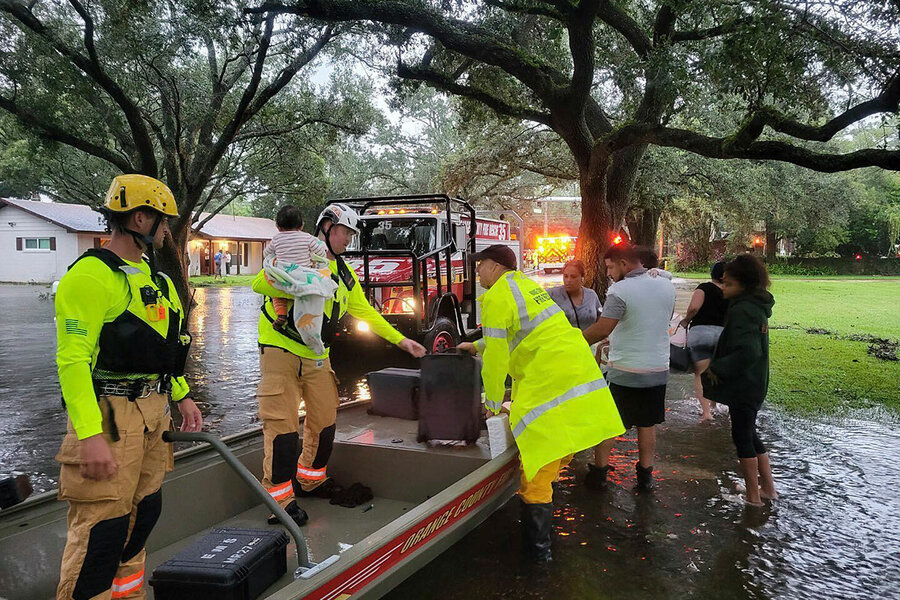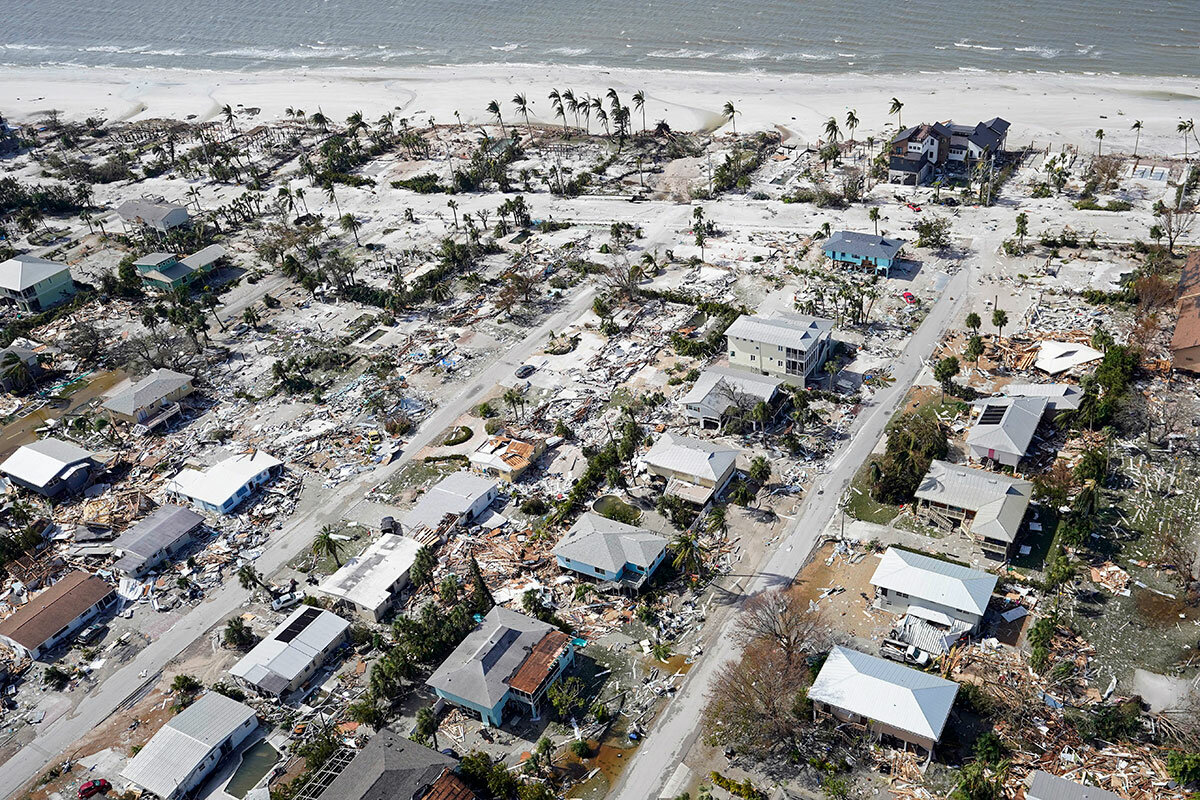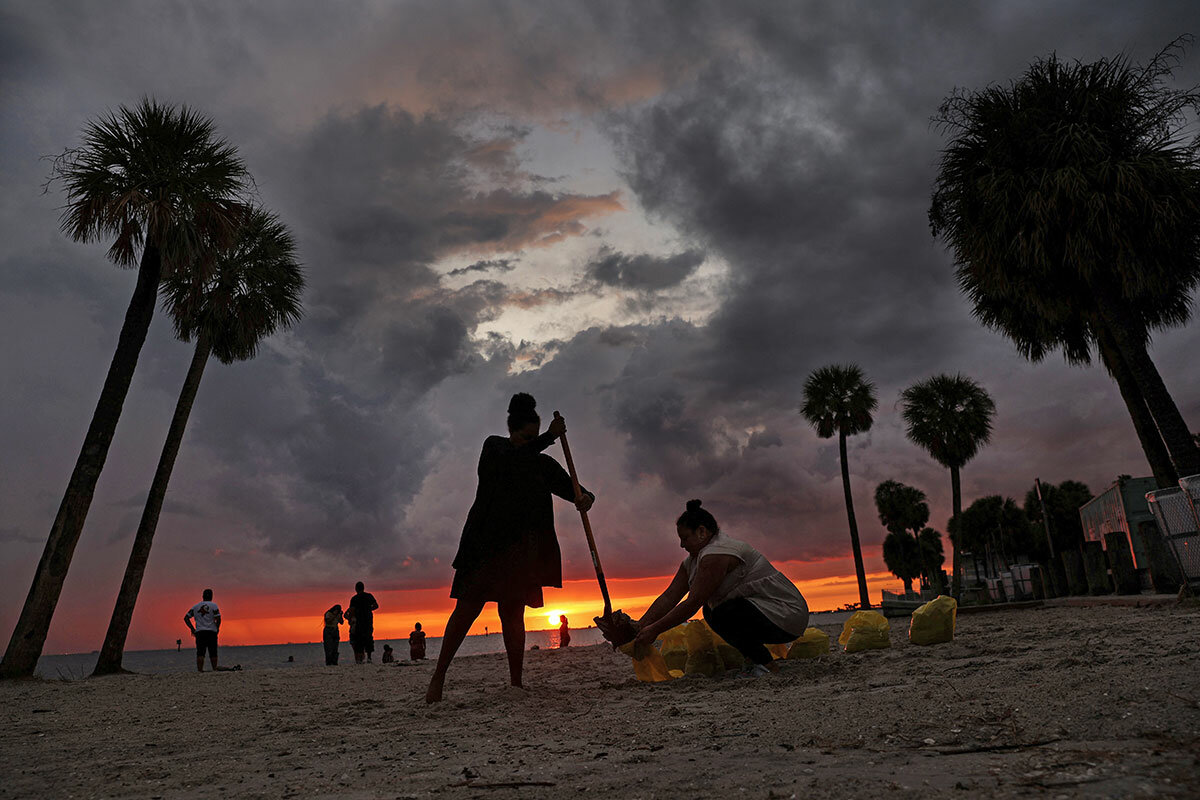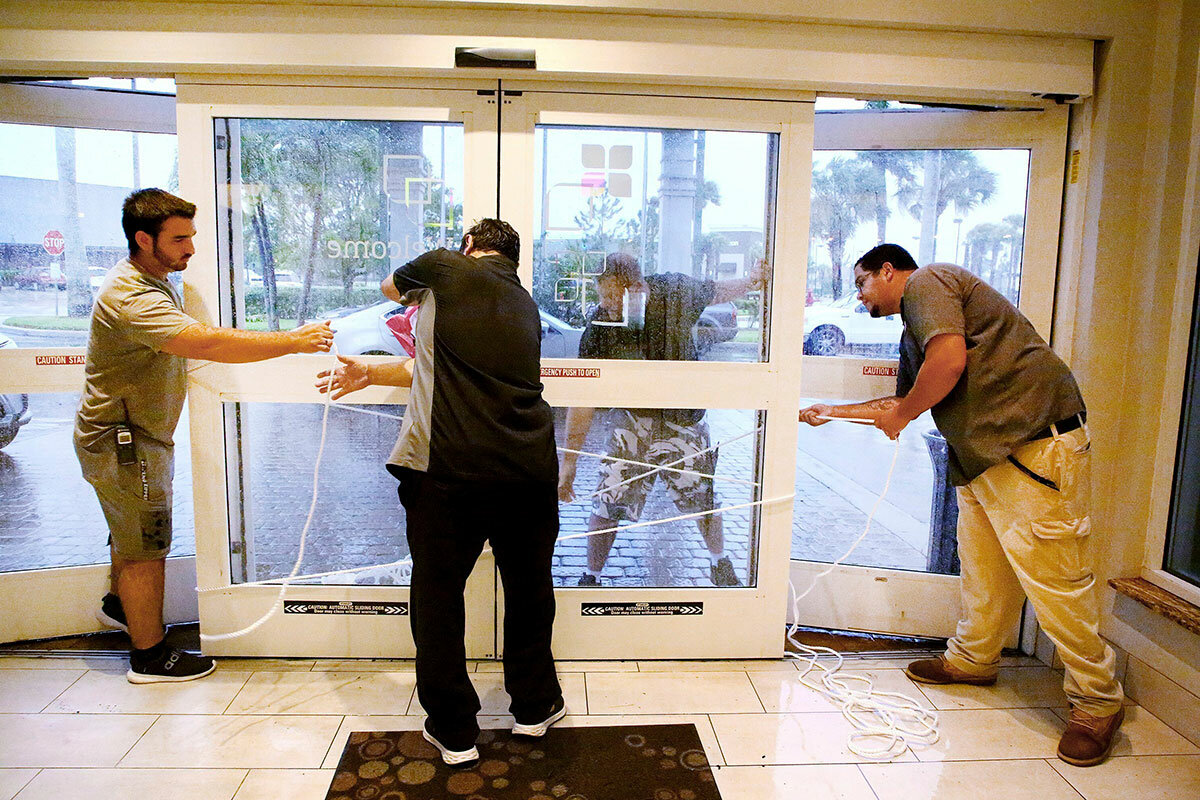Florida has invested in resilience. Hurricane Ian is a sobering test.
Loading...
| SAVANNAH, Ga.; and NEW ORLEANS
As Atlantic storms continue to increase in power and impact, Americans have not yet blinked about setting down roots in their path.
Hurricane Ian lumbered onto land at 3:05 p.m. Wednesday near Cape Coral and Fort Myers, an area of Florida that has seen a stunning 623% population increase since 1970. Two-thirds of those people live in a flood zone, like the winding canal-oriented neighborhoods at the core of Cape Coral’s unique appeal.
As those neighborhoods took a battering Wednesday, Hurricane Ian underscores the challenges that define coastal living and communal responses to storms that are only growing more powerful and expensive.
Why We Wrote This
A story focused onHurricane Ian, one of the strongest-ever hurricanes making landfall in the U.S., comes after an era of major coastal development. But Florida has also ramped up preparedness.
As it moves into the Atlantic on a northward path into another possible landfall in South Carolina, the hurricane is testing, head-on, efforts in Florida and beyond to shore up preparedness, including emergency operations, electric grid improvements, humanitarian relief, and building codes.
The extent to which those preparations are offset by massive development along the 1,300-mile-long Florida coast may yield insights into the impacts of changing storm patterns and intensity on how and where Americans live – and at what cost.
What are Ian’s current and projected effects?
After wiping out power across Cuba, Hurricane Ian came ashore on Florida’s Gulf Coast, bringing up to 150-mph gusts and a storm surge that inundated neighborhoods, picking some homes off their foundations. Part of the causeway linking Sanibel and Captiva to the mainland collapsed, making the islands unreachable by ground.
Some 2.5 million people were under evacuation orders, and many heeded them as highways crammed with fleeing vehicles days before the storm.
By estimates that are merely preliminary, the storm may cause some $70 billion in property damage, placing it among the top tier of Florida’s history of costly hurricanes. Hurricanes Irma in 2017 and Michael in 2018 were also massive storms. Irma alone caused $77 billion in damages.
As of Thursday morning, more than 2.5 million Florida customers were without power. Some of the state’s most battered localities, like Naples in Collier County, have issued boil-water notices. The National Oceanic and Atmospheric Administration’s monitoring system recorded more than 6 feet of storm surge in the area near Naples at Ian’s peak on Wednesday. Gov. Ron DeSantis, whose administration is undergoing its first test of natural disaster preparedness, stated that more than 30,000 electrical linemen were already helping to restore power.
Governor DeSantis described Ian’s impact as “historic” during a press conference.
“Today is about identifying the people who need help and may still be in harm’s way,” he said. Some deaths caused by the storm had been confirmed Thursday, while some people in Ian’s path lack cellphone service to call for rescue.
President Joe Biden declared a major disaster on Thursday and pledged federal aid, saying the hurricane caused “substantial loss of life” and could rank among the worst to hit the state. He promised that the federal government will cover the full costs of search and rescue efforts and cleaning up debris and will help rebuild schools and infrastructure. He also offered financial assistance to residents with inadequate homeowner’s insurance.
Were Floridians ready?
By dint of its jutting geography, Florida bears more of the nation’s hurricane hits than any other state. Ian became the 121st hurricane to hit the state since 1851.
That frequency means that Floridians tend to be ready for the worst. County emergency centers are well-oiled machines.
The state has also made huge strides in building codes since Hurricane Andrew in 1992, mandating that new homes in high-velocity zones withstand 120-mph winds. (Though Ian is proof that the worst storms can be stronger than that.) The Journal of Risk and Uncertainty in Engineering Systems found that Florida homes built since the early 2000s experience significantly lower losses than homes built in the previous decade.
Increased flooding threats have also sparked action. In 2015, the state Legislature passed a “flood in peril” law that mandated all municipalities update their storm readiness plans.
After the 2004-05 storm season, when 10 named storms caused $28 billion in property damages, the Florida Public Service Commission held a series of workshops with officials and industry representatives to brainstorm strategies for how to mitigate power outages and restore power more quickly.
In 2019, the Florida Legislature hardened that process by creating a new way for utilities to recover costs associated with upgrading the grid, instead of using base rates to recover those costs.
Dozens of major cities and regions have climate change preparedness councils, some of which have run major-hurricane simulations. Lessons learned are widely shared among officials. And with Hurricanes Michael and Irma fresh in residents’ minds, a sense of caution prevailed in preparations for Hurricane Ian that likely saved lives.
“Once these emergency operations centers pull the trigger ... they are on top of stuff,” says Mark Hafen, an expert on coastal resiliency, now in Toronto after a career in Florida. “And they need to be, because they have allowed rampant development in the coastal zone, and there is no way of undoing that right now.”
Is climate change affecting the severity of storms like Ian?
The frequency of hurricanes has not dramatically changed, but climate shifts are playing a role in the impact of named storms.
Climate researchers have taken note in recent years of how the rapid intensification of storms like Ian is occurring closer to the coastal areas. Jill Trepanier, an environmental scientist at Louisiana State University who studies climatic and erratic weather phenomena, says that this type of acceleration is due to an increase in heat energy, which is drawn from Gulf coastal waters that are “so hot, it’s almost bath water.”
Slowly warming seas provide extra fuel, increasing the frequency of Category 4 storms.
Rising air temperatures mean the atmosphere can hold more moisture, forming larger, slower, and wetter rotations.
An April 2022 study in the journal Nature Communications found that climate change raised hourly rainfall rates in hurricanes by 8% to 11% during the unusually active 2020 hurricane season.
Hurricane Ian appears to embody the trend. Its most dramatic impact was its massive storm surge and tree-felling winds. But only about 7% of storm-related deaths occur in storm surge events. Most people killed in hurricanes are victims of inland flooding.
In Ian’s case, the slow-moving storm is forecast to drop as much as 20 inches of rain on Florida before it moves through Georgia up into the Carolinas, with between 2 and 5 inches forecast for Georgia and up to 12 in the Carolinas.
Ian is currently moving at 9 mph. Dr. Trepanier expects the storm to gradually break apart over the next two days.
How are those dynamics changing the conversation around regional natural disaster preparedness?
Florida has long relied on development as a main piston of its economy, one that creates an ever-widening tax base that funds government services, including schools, parks, and recreation.
The pandemic only fueled the state’s in-migration patterns, led primarily by transplants from the East Coast and the Midwest. Today, some 15 million Floridians, or 76%, live in a coastal zone.
“Even though cities are supposed to be trying to curb development, they aren’t,” says Mr. Hafen, retired director of the Master of Urban & Regional Planning program at the University of South Florida in Tampa. “I see it in Tampa: development in areas that in 20 years are going to be underwater. They do things like, ‘Well, we’re going to elevate the building.’ But what happens when the water stops receding? Are you going to kayak to work?”
The tension is evident in policy and politics. Even as the Legislature has hardened some storm protections, pressure to relax building codes is ever-present from builders anxious about their profit margins.
“Despite the increasing severity of natural disasters, [many states, including Florida] have relaxed their approach to codes – or have yet to impose any whatsoever,” according to a 2018 report from the Insurance Institute for Building & Home Safety.
But those opposing forces – stronger storms and pressure to relax regulations – may come to a head in Ian’s wake.
The state’s insurance industry is in shambles after several years of expensive storms and fraud problems involving roof contractors. The Legislature has created an “insurer of last resort” whose policy book has grown quickly as other insurance companies have either left the state, stopped writing policies, or gone bankrupt.
But if damages from Ian go too high, experts warn that insurer, called Citizens, may run out of cash. That could put U.S. taxpayers on the hook for paying for the consequences of Florida’s growth and development patterns. Taxpayer-subsidized federal flood insurance has also served as an incentive for Americans to live in beautiful but flood-prone areas.
Florida political leaders paint the state as a beacon of personal liberty, a bulwark against progressive causes. That is not necessarily a barrier to preparedness, but it can complicate readiness. One example: The Republican-led Legislature passed the climate change-related “flood in peril” bill at a time when state officials were barred from using the phrase “climate change.”
But sentiments may be changing among Florida residents. As of last year, 48% of Floridians believe that climate change will affect them directly, up from 42% in 2018, according to polling by the Yale Program on Climate Change Communication.








